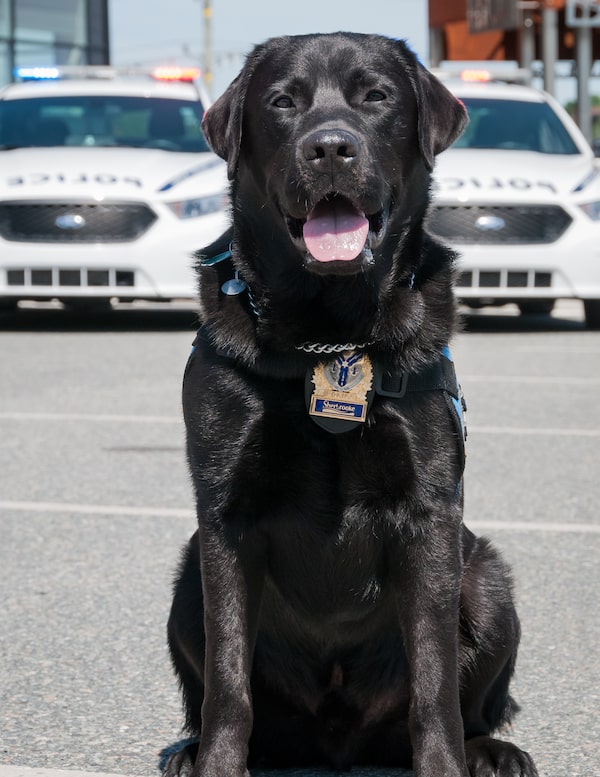
Prior to his retirement, Kanak worked with the Sherbrooke Police Department with victims providing emotional support.Mélanie Bedard
For five years, Kanak worked on the frontlines of the hardest cases. He lay with his head on the laps of young children being interviewed by Sherbrooke police detectives investigating sexual abuse. He offered his gentle presence as a tether for victims who had to testify in court, lying still for hours while they rested their hands on his fur. After two children saw a cousin drown, he stayed with them, watching over them with his old-soul eyes, while family members went to identify the body.
And then one day, he didn’t want to go to work any more. Assistant dogs aren’t placed in their harnesses, they leap into them willingly, but Kanak had lost his usual enthusiasm. The black Labrador retriever plodded behind his police handler, head down. He didn’t wag his tail in the same way when meeting new people.
The Sherbrooke police sent him to the Mira Foundation, which had selected him from one of their litters – even as puppy, he was preternaturally calm – and trained him specifically for his job.
His trainers decided it was time for Quebec’s first emotional support police dog to retire.
Charlotte Moses-Bélanger, co-ordinator of Mira’s rehabilitation dog projects, says they don’t like to use the word “burnout.” She explained: “We have to be careful to attach human emotions to animals.” But assistant dogs do get tired, she says. “We ask a lot of them.”
The Mira Foundation trainers check on their dogs each year. Sometimes health reasons force a dog to retire. Sometimes, as with Kanak, they just exhibit a certain weariness around a job they used to be keen to perform. But Kanak is also almost seven years old – a respectable retirement age, Ms. Moses-Bélanger says, for an emotional support dog expected to manage different people and scenarios each day. In Kanak’s case, that meant 429 interventions during his service with the Sherbrooke police. His retirement is “well deserved,” she says.
Humans are using dogs to provide emotional support to humans in an increasing number of places, including schools, psychiatric units and prisons. After 40 years of training, the Mira Foundation alone has 780 dogs on the road, and another 2,070 that are non-active. The foundation breeds and trains dogs to assist people who are blind or disabled, or to provide support to children with autism. Some dogs, such as Kanak, are placed in youth centres, homeless shelters, paramedic stations.

Kanak was selected for the job based on his calm nature as a puppy.Mélanie Bedard
The presence of a calm dog has been found to lower blood pressure and reduce stress hormones in humans. But the expanding use of facility dogs to emotionally support humans has also raised ethical questions among researchers, including whether dogs actually enjoy the work. A 2018 study by American researchers followed 26 dog-handler teams paired with pediatric cancer patients for four months, and found no evidence of increased stress symptoms in the dogs. But a commentary published in the journal Animals last year called for clear standards around selection, training and monitoring of assistance dogs – both for safety of the humans, and the well-being of the animals.
This is why, in addition to the regular check-ups, Ms. Moses-Bélanger says the Mira Foundation is careful to ensure a dog works a reasonable number of hours in a safe setting, and develops a close bond with one handler. “They really need an anchor,” she says.
For Kanak, that anchor became Mélanie Bédard, a Sherbrooke police officer who first proposed the idea of an emotional-support police dog. She met Kanak when she was sent to Mira for her handler training. “His stare is so deep,” she says. “It really reaches your soul.” Nothing rattles him, she says. “If anybody screams or shouts, he just looks up, as if to say, ‘Can somebody take care of that?’ ” To preserve his mellow personality – and prevent separation anxiety – he travelled everywhere with Ms. Bédard. He even went to the movies, sleeping under her chair.
He was soon famous in Quebec, with a Facebook page of 13,000 followers. He was recognized at the grocery store. His effect during tearful interviews and emotional testimony, especially with children, was obvious, Ms. Bédard says. “Before Kanak, we would not often see smiles from victims,” she says. Even adults told her that he gave them the courage to testify in court. “They didn’t feel alone standing in front of the judge.”
For Ms. Bédard, though, the job of serving as quiet witness to heartbreaking testimony and terrible sadness eventually became unbearable. Kanak was called to the most traumatic cases – to comfort children who found their mother murdered, or teenagers in shock over a parent’s suicide. Sometimes, Kanak attended when police had to inform families that a loved one had died. Ms. Bédard was always there too, and as cases wound through the system, “I would hear the stories not once, but two or three times.” After the third year, stricken with “compassion fatigue,” she took a mental-health leave, and eventually realized she couldn’t go back.
Kanak went to live with a new handler, and worked for 18 months, before his behaviour suggested that it was time to retire.
Today, Kanak is back home with Ms. Bédard, so the other handler can receive his replacement, who is currently being trained.
“He is back to his old self again,” she says. In true Kanak style, this means he lets her other two dogs do the ball chasing; he sleeps on the couch and savors belly rubs. When she gets the keys, he still jumps up and heads to the door. But now it’s for play, not work – the best reward, well earned.
Our Morning Update and Evening Update newsletters are written by Globe editors, giving you a concise summary of the day’s most important headlines. Sign up today.